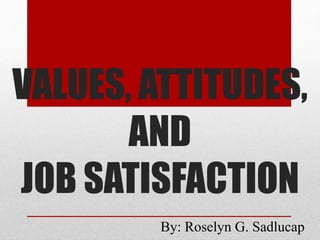VALUES, ATTITUDES PPT REPORT IN EDUC 203.pptx
•Download as PPTX, PDF•
0 likes•16 views
Chapter 4 Educ 203 Values, Attitudes and Job Satisfaction
Report
Share
Report
Share

Recommended
More Related Content
Similar to VALUES, ATTITUDES PPT REPORT IN EDUC 203.pptx
Similar to VALUES, ATTITUDES PPT REPORT IN EDUC 203.pptx (20)
Notes on Attitude & Values in Organisation Behavior

Notes on Attitude & Values in Organisation Behavior
On attitudes-and-job-satisfactionok-1233836501262150-1

On attitudes-and-job-satisfactionok-1233836501262150-1
HBO Handout Chapter 3 (Individual Differences and Work Behavior)

HBO Handout Chapter 3 (Individual Differences and Work Behavior)
Recently uploaded
https://app.box.com/s/tkvuef7ygq0mecwlj72eucr4g9d3ljcs50 ĐỀ LUYỆN THI IOE LỚP 9 - NĂM HỌC 2022-2023 (CÓ LINK HÌNH, FILE AUDIO VÀ ĐÁ...

50 ĐỀ LUYỆN THI IOE LỚP 9 - NĂM HỌC 2022-2023 (CÓ LINK HÌNH, FILE AUDIO VÀ ĐÁ...Nguyen Thanh Tu Collection
Recently uploaded (20)
Sectors of the Indian Economy - Class 10 Study Notes pdf

Sectors of the Indian Economy - Class 10 Study Notes pdf
MARUTI SUZUKI- A Successful Joint Venture in India.pptx

MARUTI SUZUKI- A Successful Joint Venture in India.pptx
Basic phrases for greeting and assisting costumers

Basic phrases for greeting and assisting costumers
Instructions for Submissions thorugh G- Classroom.pptx

Instructions for Submissions thorugh G- Classroom.pptx
50 ĐỀ LUYỆN THI IOE LỚP 9 - NĂM HỌC 2022-2023 (CÓ LINK HÌNH, FILE AUDIO VÀ ĐÁ...

50 ĐỀ LUYỆN THI IOE LỚP 9 - NĂM HỌC 2022-2023 (CÓ LINK HÌNH, FILE AUDIO VÀ ĐÁ...
Basic Civil Engineering Notes of Chapter-6, Topic- Ecosystem, Biodiversity G...

Basic Civil Engineering Notes of Chapter-6, Topic- Ecosystem, Biodiversity G...
Salient features of Environment protection Act 1986.pptx

Salient features of Environment protection Act 1986.pptx
INU_CAPSTONEDESIGN_비밀번호486_업로드용 발표자료.pdf

INU_CAPSTONEDESIGN_비밀번호486_업로드용 발표자료.pdf
Benefits and Challenges of Using Open Educational Resources

Benefits and Challenges of Using Open Educational Resources
UNIT – IV_PCI Complaints: Complaints and evaluation of complaints, Handling o...

UNIT – IV_PCI Complaints: Complaints and evaluation of complaints, Handling o...
VALUES, ATTITUDES PPT REPORT IN EDUC 203.pptx
- 1. VALUES, ATTITUDES, AND JOB SATISFACTION By: Roselyn G. Sadlucap
- 2. VALUES refers to the importance a person attaches to things or ideas that serves as guide to action. Made of set of beliefs.
- 3. HOW PEOPLE LEARN VALUES Values can be learn through any of the following: 1.Modeling 2.Communication of attitudes 3.Unstated but implied attitudes 4.religion
- 4. Modeling Parents, teachers, friends, and other people oftentimes become models to persons who would later exhibit good behavior in the workplace.
- 5. Communication of Attitudes When a person often hears from acquaintances the risk of buying products imported from a certain country, the person may develop negative values about the country.
- 6. Unstated but Implied Attitudes If a person sees joy and happines in every member of his family whenever another member graduates from college, the person will develop the same values impliedly exhibited.
- 7. Types of Values: 1.Achievement – pertains to getting things done and working hard to accomplish goals; 2.Helping and concern for others-refers to the person’s concern with other people and providing assistance to those who need help; 3.Honesty-indicates the person’s concern for telling the truth and doing what he thinks is right; and 4.Fairness – indicates the person’s concern for impartiality and fairness for all concerned.
- 8. Individual versus Organizational Values Organizations have values that may or may not be compatible with the values of the individual workers. ORGANIZATIONAL VALUES ORGANIZATIONAL VALUES INDIVIDUAL VALUES POSITIVE FEELINGS CONFLICTS INDIVIDUAL VALUES When -– congruent — with the when --- incongruent --- with the = = Figure 11 EFFECTS OF VALUE CONGRUENCE AND INCONGRUENCE
- 9. Espoused versus Enacted Values Espoused values- are what members of the organization say they value Enacted values – are those that are reflected in the actual behavior of the individual members of the organization
- 10. Instrumental and Terminal Values Terminal values- represents the goals that a person would like to achieved in his/her lifetime. Instrumental values – refer to preferable modes of behavior or means of achieving the terminal values
- 11. ATTITUDES Is important in the study of human behavior. They are linked with perception, learning, emotions, and motivation. The basis for job satisfaction in the workplace. Reflect how one feels about something.
- 12. The Main Components of Attitudes Attitudes consist of the following components: 1.Cognitive 2.Affective 3.Behavioral
- 13. Cognitive component refers to the opinion or belief segment of an attitude Affective component refers to the emotional or feeling segment.
- 14. Behavioral component refers to the intention to behave in a certain way toward some one or something.
- 15. COGNITIVE (evaluation) AFFECTIVE (feeling) BEHAVIORAL (action) Negative Attitude Toward boss My boss is fickle-minded; He cannot stick to his decision I hate my boss I am requesting for a transfer Figure 13 THE COMPONENTS OF AN ATTITUDE
- 16. Differences in Personal Disposition: People differ in their personal disposition: Positive affectivity-refers to personal characteristic of employees that inclines them to be predisposed to be satisfied at work. Negative affectivity-is a personal characteristic of employees that inclines them to be predisposed to be dissatisfied at work.